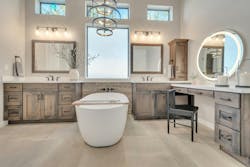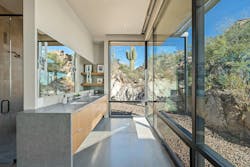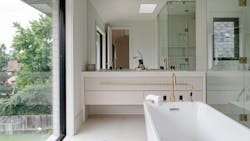Smart Fixtures, Bigger Showers, and Personalized Layouts Lead 2026 Bath Trends
Key Highlights
-
Wellness-driven bath projects—larger showers, smart fixtures, and hotel-inspired layouts—continue to shape homeowner expectations
-
Natural materials and durable, low-maintenance surfaces dominate selection trends for 2026
-
Universal design is transitioning from optional upgrade to mainstream requirement in primary bath remodels
BETHLEHEM, PA — The National Kitchen & Bath Association (NKBA | KBIS) has released its 2026 Bath Trends Report, outlining the design priorities, materials, and technology features expected to drive bathroom projects over the next several years. Based on feedback from nearly 700 designers, remodelers, manufacturers, and other industry professionals, the report offers contractors a forward look at what homeowners are requesting—and where project demand is growing.
According to the survey, bathroom design is entering a transition period shaped heavily by new residential technology. Smart fixtures, advanced lighting, and wellness-focused systems are expanding rapidly, especially among younger homeowners who are leaning on AI tools to guide style and layout decisions.
Technology Shaping Project Expectations
Across the industry, three technology areas are generating the most momentum:
-
Tech-Based Inspiration: Homeowners increasingly turn to AI tools for project ideas that combine smart features, sustainability, and aesthetics.
-
Smart Fixtures and Systems: Intelligent showers, lighting, ventilation, and energy-use controls continue to scale across price points.
Wellness Technology: Stress-reduction features, health-monitoring tools, and aging-in-place upgrades are shifting from specialty offerings to mainstream expectations.
Personalized Styling Drives Materials and Layout
Design professionals report that clients are prioritizing colors, materials, and storage solutions that better support their daily routines. “Bath design is becoming deeply personal,” said Bill Darcy, Global President & CEO of NKBA | KBIS. “Beyond considerations like resale value, designers are focusing on how spaces support a homeowner’s individual rituals, preferences, and self-care routines.”
Survey findings indicate clear direction for contractors:
-
Light neutrals dominate bath color palettes, with off-white, tan, and white leading choices.
-
Earthy, brown-based greens—especially sage and olive—remain popular accent colors.
-
Transitional/timeless design is the top style choice for the next three years, followed by organic/natural looks.
-
Homeowners want fewer grout lines and durable, low-maintenance flooring. Large-format tile is widely expected to remain the top selection.
-
Wood-faced vanities are gaining ground over painted finishes as natural materials continue trending.
-
Polished faucet finishes are losing share to matte, brushed, and satin options.
Primary Baths Growing to Support Wellness
Roughly three-quarters of respondents expect bath footprints to increase to accommodate wellness features, universal design elements, and improved storage. In the primary bath, contractors report that:
-
Larger showers are preferred over bathtubs by more than half of homeowners.
-
Spa-like features—steam, aromatherapy, chromotherapy, saunas, and built-in seating—are driving many layout changes.
Integrated shelving and custom storage remain high-value additions for simplifying daily routines.
Hospitality-Inspired Design Gains Ground
According to the report, 77% of respondents say that hotel-style design cues are becoming more common, fueling interest in cohesive wellness, smart technology, and sustainability solutions. Textured and patterned tile continues to gain traction, and smart toilets are expected to increase in popularity as well.
Smarter Storage and Personalized Features
Demand for configurable storage continues to rise—particularly solutions designed around everyday items such as grooming tools, medication, and electronics. Electrical integration inside cabinets, charging stations, and purpose-built drawer organizers are becoming standard upgrades in many projects.
Universal Design Becomes Mainstream
Aging-in-place solutions are now expected to be both functional and visually appealing. Survey respondents pointed to curbless showers, benches, grab bars, barrier-free entries, and wider doorways as features that elevate both safety and design. Nearly half say these upgrades are on track to become common fixtures in primary bath projects.
The full report is available at NKBA.org, with free access for NKBA members.
Note: this press release was rewritten with help from generative AI.


